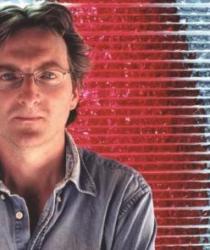
Simon Hitchens has been a professional sculptor for over twenty years (you can view some of his work on his website, www.simonhitchens.com). However, there was a time when he might have been lost to the world of sculpture. His decision to attend Foundation College at Farnham School of Art, immediately after leaving Bedales, was made, almost literally, on the flip of a coin. “I was seriously considering going off to learn how to make musical instruments at the London College of Furniture instead,” he explains.
“At Bedales, my love of material, of stuff, really began to emerge. My influences came from David Butcher and his amazing workshop, where I always felt at home. I can still smell that marvellous wood and his aromatic tobacco. Time had a quiet, studied pace, where skill and patient craftsmanship were rewarded with things of beauty. Another huge influence came from the barn-building that we did under the worldly-wise leadership of John Rogers. John still inspires me to this day with his endlessly refreshing take on life, smattered with good-humoured candour. My real love, and my fondest memories of Bedales, concerns those unique extra-curricular activities.”
Although he is the son, grandson and great-grandson of painters, Simon never felt pressure to follow in the family tradition. He remembers a similar lack of coercion at Bedales: “School enabled me to max out on the things that I loved in life, it gave me the opportunity to understand the cause and effect of it all and allowed me the freedom to make mistakes,” he muses. “The overriding flavour of life was a feeling of warmth and a sense of belonging: many of my peers are still good friends of mine.”
At art college, Simon’s sculptural influences were mainly the group of new British sculptors – Tony Cragg, Richard Wentworth, Richard Deacon, Anish Kapoor. “They spoke to me in an idiom that the industrial sculptures of people like Caro simply didn’t, and seemed light years away from Henry Moore and his generation. I was also interested in the land art of Richard Long, Nancy Holt and Michael Heitzer, to name but a few. My entire second year was spent digging up the grounds of the art college, rearranging the earth and turf to make unexpected interventions in the landscape.” But stone was the medium which was becoming increasingly important to him. “It wasn’t exactly a conscious decision,” he emphasises, “I’ve always liked working with rock, I instinctively understand and respect it. I took geology at O-Level, which started a fascination with deep time and the material history of the earth. To discover that I could cut rock with a saw or split it with wedges, so revealing ancient hidden interiors, was an exhilarating discovery, full of possibilities for new work.”
“Around this time though, the greatest passion in my life, bar none, was rock-climbing. This tied together my love of rock and nature with the physical crafts needed to move in the vertical world safely. It was, and is, utterly exhilarating. I was hooked from the very first day I climbed, on the Dartmoor summer camp at the end of Block 4, and by the time I started my degree, I’d completed my first season’s climbing in the Alps. I think that in part, my fascination with rock derives from the way in which it resists me. You need immense patience and time to achieve your goals when working with a hard medium like that, unlike clay for example, which is just too malleable for my liking.”
After ten years, Simon had stopped working with stone, feeling that he had taken it as far as he could as a medium to make contemporary sculpture, and chose to work in the more contemporary medium of clear cast resin instead. “I returned to stone a few years later,” he explains, “when I found a way of working it in a more direct manner which did not involve carving. I became interested in presenting the rock itself as an inherent part of my work, not just as a medium to display my level of skill of craft. Now, I combine pieces of rock, the natural world, with contrasting man-made materials as a way of talking about the Human Condition. I’m finding that to take visible elements of skill and craft out of the work makes for more interesting and resonant sculpture.”
The titles of some of Simon’s sculpture exhibitions – ‘Seeking the Sublime’, ‘In the Presence of Absence’, ‘A Separate Reality’ - over the last decade give a hint of his preoccupation with the relationship between form and emptiness. “The Japanese-American sculptor Izamu Noguchi was quite an influence on me in that respect,” Simon says. “Although I’m slowly drifting away from that sort of Zen aesthetic, the work retains a clean minimal balance. The idea of a meditative state of positive emptiness makes complete sense to me. It’s what I feel about what I do, which is, after all, a solitary pursuit. The thing is that I’m also gregarious and need to have my friends around me, yet the moments when I can shut my studio door and get down to work are extremely precious.” Simon now divides his time between pushing new ideas forward, making sculpture for exhibitions, and working on large public or private commissions. “I enjoy working with other professionals in order to realise a large public work, yet it’s incredibly important to me that I have consistent time to myself in the studio. Perhaps this passion has now replaced that of climbing,” he muses.
“It’s odd how things shape our lives,” Simon concludes. “Frankly, I didn’t learn much at art college, but those extra-curricular things I got up to at Bedales, plus a sense of believing that anything is possible in life, have stayed with me since I left.”
Simon Hitchens was interviewed by James Fairweather in February 2013.

